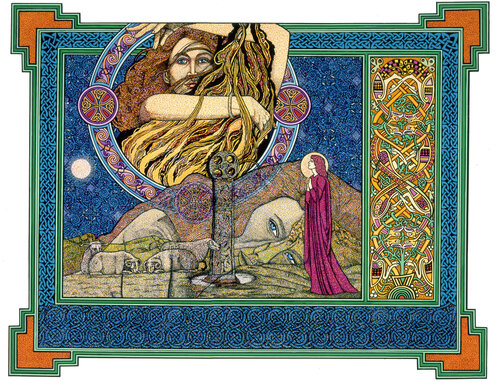
This blog is written to honour our Celtic Goddess and Christian Saint, Brigid, (Brigit, Brig, Brid, Bride) and to celebrate the newly instated bank holiday marking St. Brigid’s Day and our ancient Celtic festival Imbolc on the 1st of February.
Brigid is known as a triple goddess in pre-Christian Irish Mythology. Cormac’s Glossary (written by Christian scribes in the 9th Century) references Brigid as the Three Mothers or the Three Sister Selves- The Goddess of Healing, the Goddess of the Sacred Flame and the Goddess of the Fertile Earth. She appears in Irish legend in many forms, as a deity of spring and new life, fertility, of fair weather, a guardian of domesticated animals and agriculture, a sage of poetry and prophecy, a symbol of the rising sun and the dawn and a patron of smith craft.
She was believed to be a Goddess of the Tuatha Dé Danann, (the Godly tribe of Danu), daughter of the High King Dagda and wife of Bres, an unfavourable Fomorian who later became High King of the Tuatha Dé Danann. She bore a son named Ruadán who died in battle at a very young age. It is disputed who her mother was but some legends say she was the daughter of Danu, the mother Goddess of the Tuatha Dé Danann, or the great queen of war the Goddess Morrigan. Regardless of who it was, tales of Brigid’s power and influence far exceed both of these Celtic Goddesses. Her name in Gaelic translates as “fiery arrow”, “fiery power”, or “exalted one”.
The pagan Brigid was one of the most highly revered Goddesses in prehistoric Ireland. It is believed this is why the Christian Church re-appropriated her image and reinvented her as St. Brigid of Kildare. Her influence was so potent she was canonised by the Christian Church and is now regarded as one of Ireland’s three patron Saints along with St. Patrick and St. Colmcille. Patron, meaning the heavenly guardian of our nation.
In pre-Christian times, Goddess Brigid was worshipped at Imbolc as she was believed to bring fertility to the land. The feast of Imbolc was one of four important festivals on the Celtic calendar marking the beginning of Spring. Imbolc translates as “in the belly” and a time of the first milk, the ewes milk, when the first calves are born. The Celtic calendar was created as a system of timekeeping, to define the weeks, months, seasons, quarter days, and festivals. The festival of Imbolc, which starts on the eve before the 1st of February, is an ancient celebration that acknowledges the start of Spring, longer days ahead, fertility, new life and a long life. It pays homage to the great Goddess Brigid.
There are many rituals associated with Imbolc and Brigid’s feast day, now known as St. Brigid’s Day. Customs vary throughout the regions of Ireland. Celtic festivals marked the beginning of the seasons. Spring-February 1st (Imbolc), Summer- May 1st (Beltaine), Autumn-August 1st (Lugnasach) and Winter-November 1st (Samhain). These cross-quarter days are separated by regular intervals of three months, and come between the two solstices (Summer and Winter) and two equinoxes (Autumn and Spring). They divided the year into quarters. The quarter days were also the primary markers in the agricultural calendar. They helped farmers make sense of the seasonal cycle, reminding them of what natural events were current at that time and what work they should have completed. The annual cycle of the agricultural year was observed and respected. Many customs and rituals associated with the calendar therefore are associated with the farming year. Farming began in Ireland during the Stone Age, around 6000 years ago, long before the arrival of Christianity to Ireland, so the ancient festivals were adopted by Christianity and carried on. Some rituals and superstitions are still with us today. Rituals were associated with each festival but all ensured the luck and the health of the farming families and a prosperous season ahead. Some rituals included divination or foretelling of future events. Fairs and celebrations took place all over Ireland marking a time for gathering together. Celebrations began at sundown on the eve of each calendar festival. The festival of Imbolc marked the midway point between the Winter Solstice and the Spring Equinox. Acknowledging its significance, The Christians repurposed it as the feast day of St Brigid.
It is unclear how Brigid the Celtic Goddess became Brigid the Saint. Some folklore suggest her grief for the loss of her son in battle led her to convert and live a monastic life. Other stories suggest she may have been a slave and mistreated by men, men who were intimidated by her powers. Legend has it she pulled out her own eye so she was no longer attractive and retreated to the solitude of monastic life where her eye miraculously healed. Many stories suggest the Christian Missionary St. Patrick, credited for bringing Christianity to Ireland, was very skilful in convincing the Celts that the new faith coming from Rome was merely an extension of their own traditions, beliefs and faith. There are so many versions of tales and lore of this enigmatic female, Brigid. Whether she was real, a mythical character, one of the same or another name sake, one thing is for certain, the Christian Church knew how important it was to adopt this powerful persona to influence their own agenda.

There are many early Christian stories of St. Brigid of Kildare. She is said to have converted an old pagan king of Ireland to Christianity on his death bed by taking rushes from the floor and making a simple cross to explain the concept of Christianity. This cross is still made today in schools and homes all across Ireland. The Christian Church made St. Brigid the patron saint of cattle and dairy work. She was said to be accompanied on her travels across Ireland by a single white cow. Young lambs were said to be nourished by the milk of her flower, the dandelion. On the eve of her feast day, Saint Brigid passed over all of Ireland to bestow her blessings to the land and people. Offerings were left out for her such as bread and butter. Items were also left out for her to bless as she passed over. The house was cleaned and tidied before St Brigid’s Eve. Fresh rushes were collected and spread on the floor. This is traditionally a sign of welcome. From those rushes St. Brigid’s crosses were woven and placed under the food that was eaten on St Brigid’s Eve and the next day. A bed of rushes was made for the saint that night and the door was left on the latch if the saint wished to enter the house and rest. Some people left a piece of cloth outside for the night of St Brigid’s Eve. The belief was that it would be touched by the saint on her travels as she transferred her curative power. This became known as Brigid’s cloak and was worn by people within their clothing as an amulet to promote healing. It was used as a cure for many ailments from headaches to labour pains and was also given to people undertaking long or dangerous journeys.
Another legend associated with Brigid was the tale of the magical cloak. It is believed that she chose a site for her convent that belonged to the King of Leinster. She met him to discuss how she could acquire the land. The king said he would only give her the amount of land for her convent that her cloak covered. This was said mockingly but Brigid agreed and when she lay her cloak on the ground, it miraculously grew and spread for miles. Thus she was allowed the land for her religious community.
On Brigid’s Eve, the eve of Imbolc it was custom to place crosses in the home and in the stables were animals dwelled. The cross was believed to offer protection for the household, farm and land and was even believed to protect the household from fire and lightning. Traditionally, the old cross from the previous year was burned and the new cross was blessed with holy water before being placed up high in the house for the year ahead. Burning the holy object may seem sacrilegious to Christians but this was an ancient Celtic custom that people really had held onto. This shows how people intrinsically understood and respected the Celtic beliefs and how both faiths ran parallel to each other.
Fresh green rushes on the floor were an important symbol in Ireland to welcome guests and indicate the dwelling had been prepared and was clean. Leftover rushes were made into other objects as well, such as the Brigid dolls and wicks for candles. Brigid Dolls or Brídógs were made as an honour and tribute to the goddess of fertility and Spring. The dolls were usually adorned with small stones, shells, ribbons, and a small wand made out of birch as a nod to Brigid’s magical powers. These dolls were crafted and placed next to the fireplace to welcome light and fortune to the home.
Brigid is also linked with water, and several wells across Ireland were erected as a tribute to her and are very popular pilgrim sites still to this day. One of the most famous is the well and shrine in Faughart, Co.Louth. It is believed that Brigid was born here. Faughart used to be the site of a major monastery – now it’s a Shrine in honour of the formidable Saint. St. Brigid’s Well in Liscannor, Co.Clare, located near the Cliffs of Moher is one of the oldest wells in Ireland. It is located at a site of pre-Christian Lughnasadh celebrations and is believed to have very potent healing powers. Another such well is St.Brigid’s well in Kildare town. This shrine is on the grounds where the location of her double monastery once stood.
Reputedly, Brigid died in Kildare, but her body was exhumed and removed to a beautiful idyllic spot on the foothill of Downpatrick, for burial beside the remains of St Patrick and St Colmcille. Brigid the Goddess and Saint earns her rightful place and reverence in our historical timeline. Today Brigid is a symbol of divine feminine power and compassion. She is synonymous with healing potential in our world at a very pivotal moment in our evolution. We can thank the organisation “Herstory”- www.herstory.ie for reviving interest in Brigid, our Goddess and Saint. They are responsible for spearheading the campaign to make St. Brigid’s day a national holiday and are also leading Irish celebrations to launch the new bank holiday. Check out their website to see what’s going on around the country. Herstory are a sustainable organisation promoting women’s empowerment in Ireland and worldwide. They are doing this through education and the arts. They hope to inspire female empowerment and equality through co-creation while influencing future generations of change-makers, leaders and peace-builders- Just as our legendary Brigid did.
Beannachtaí Lá Fheile Bríde Oraibh go Léir– Happy St.Brigid’s Day to Everyone
